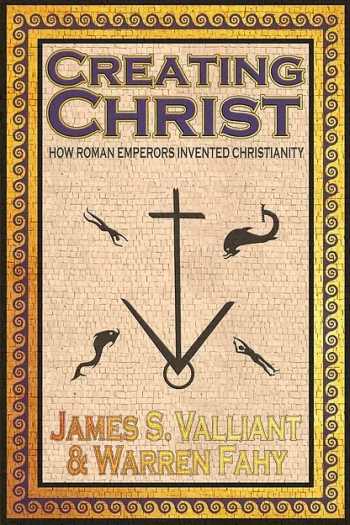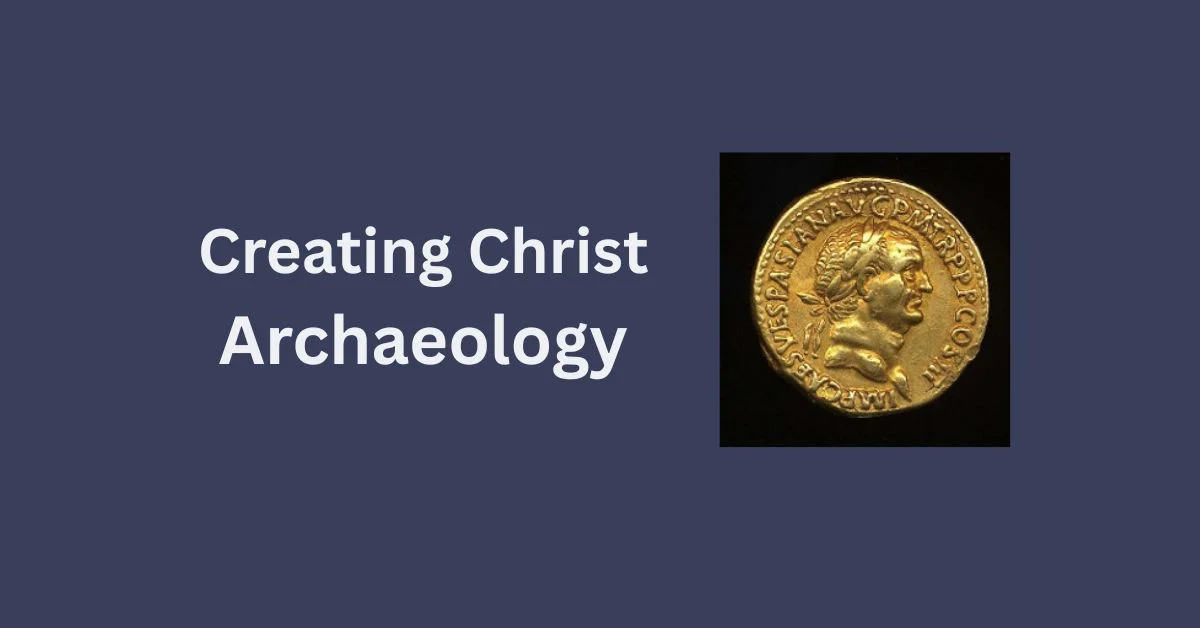This is a republishing of the Metaphysics of Physics podcast interview with Warren Fahy, one of the authors of Creating Christ. We discuss the archeology of Creating Christ as well as some other arguments for the thesis presented in the book.
For those unaware, the Metaphysics of Physics was the previous incarnation of this site and for a time in included a podcast. You can read the transcript or use the audio player below to listen to the interview. Or do both if you prefer!
Click here to download the episode.
Introduction
Today we have an interview with Warren Fahy, the co-author of Creating Christ. We have talked about Creating Christ before, when we interviewed the books of the other author, James Valliant. You can find that interview here. You can find out more about the book here.
Today we are focusing on the archeology of Creating Christ, although we will cover a few other issues as well. We cover some stuff that is not covered so much or at all in our previous Creating Christ interview. Meaning that you should definitely listen to this one, even if you have listened to the other one. Or should that be, especially if you have listened to the other one?
What is Creating Christ?
What is Creating Christ? Some of you may not know. It is a book that shows the Roman origins of Christianity. Not simply the fact that the Roman Empire morphed into the Catholic Church, but the thesis that the Romans created the religion!
It might sound radical, but the book makes a very compelling case for how this must be true. If you have not read it, you really should. You can get it from Amazon.
You really should listen to that interview first, as it gives a really in depth coverage of the book. Or, you can read the book first.

Please note that the Amazon Kindle edition is currently not available. As far as I can tell, this may be due to some disgruntled customer complaining about the book’s technical issues. Which I can assure, having owning a copy of it in Kindle, do not exist!
Apparently, one customer complaint can cause items to go under review and be taken off the Kindle marketplace. If so, this policy should change!
I have given them some polite feedback on this. You can too, if you want. But, please be civil. Incivility helps nobody, least of all Creating Christ or its fantastic authors!
We have not presented the transcript of this in web page form. Instead, you can listen to the audio or download the PDF transcript.
However, there may be mistakes in the transcript. Any mistakes in transcription represent our own errors or a transcription error we missed.
Click here to download the PDF transcript.
A Brief Excerpt
Dwayne: Do you and/or James have any of the coins from the book? Or more likely, replicas.
Warren: It’s amazing how readily available those coins are. I don’t have one. But I got a Vespasian coin for James several years ago. And it was like 50 cents at a convention.
The Flavian minted millions and millions of coins and they’re still quite available.
And so, I don’t. Someday I would love to have a fish and anchor Titus coin. That is certainly something I will obtain at some point.
Dwayne: In the book, we see that the cross was not the first primary symbol used by early Christians. Tell us about some of the earliest symbols they used.
Warren: Well, if you go back to the very first catacombs, the very first evidence of archaeological evidence of Christianity, what you’ll find is that the symbols they were using were not the Cross.
They were using the anchor, either flanked by fish or wrapped around by a fish. And so, these are the earliest symbols of Christianity that we know. And it wasn’t until about two or three centuries later, when Constantine
instated Christianity as the official religion of the Roman Empire, that he switched the symbol to the Cross.
He did so because he had seen a cross in the sky during a battle. And as he saw that vision, it turned the tide of the battle and he won the battle. And so, he decided to instate the cross is a symbol of Christianity.
His mother traveled to the Holy Land. And as legend has it, brought back a piece of the original cross. And that was all part of the propaganda that instituted this new symbolism.
But before that, the fish and anchor that was the predominant symbol of
Christianity. And it was also the symbol used by the Flavian Emperors
Titus and very briefly his brother Domitian.
Dwayne: Tell us about the mosaic we see on the front cover of the newest editions of the book.
Warren: Yes. Well, that, of course, was buried by the eruption of Mount Vesuvius in Herculaneum. Only two months after Emperor Titus seceded his father as emperor of Rome.
And it was an amazing find because it was almost like a legend for the symbolism used by the Christians.
Of course, there is no archaeological evidence from the first century of Christianity that has been recognized as evidence of Christianity.
So, this predated by decades, the first catacombs in which Titus’ own niece was buried. And that symbol that was on his coins, of the dolphin wrapped around an anchor, is echoed throughout those earliest Christians catacombs.
So, this symbol, this particular mosaic, was on the bottom of a pool in a gymnasium in Herculaneum. One that had originally been built by Emperor Augustus.
It was an imperial gymnasium that would have been under the care of the Flavians for decades. Because before then, Vespasian, the father of Titus had also a Flavian Emperor for 19 years.
There were always earthquakes going on in Herculaneum, because it was right next to the active volcano, Vesuvius. And so, they were constantly having to repair the bottom of pools. Because they would crack and then the water would leak out.And at the time of the eruption, there were two pools in this gymnasium.
One of which had been drained in order to effect repairs on the cracked bottom of the pool.
The other one that had this mosaic was filled, indicating that had been recently refurbished. So that would have been refurbished by the Flavians certainly.
And here they are using this symbol, which is reflected also on Titus’ coins. Where you see an anchor flanked by two dolphins. And two people swimming towards the anchor.
Exactly the sort of thing you would see in Christian catacombs for the next two or three centuries. And yet it predates Christian use of the symbol by decades.
That was astonishing. When I first found it, I called James. I think it was at 3:30 in the morning when I came across it. I was absolutely flabbergasted to see what that pool indicated.
At that point, probably nobody on earth knew exactly what an amazing find that mosaic was in terms of historical significance.
Dwayne: Which artefacts show us some of the religious syncretism going on with the figure of Christ?
I believe, for instance, that there is a depiction of Alexander the Great as Helios that seems to have inspired depictions of Jesus.
Warren: Yes, there are. There are plenty. Of course, the mystery cults of the pagan world, the Hellenistic world, are combined with the Christian concept of the Messiah. In a way that’s undeniable.
From Dionysius to Apollo, to the Sun God. All these pagan elements are combined within the idea of the Messiah. But the Jewish people would never have incorporated these into the idea of the Messiah. They had to have come from the pagan world.
And we can see those. Hercules dies and is resurrected and Dionysius is. Osiris dies and is resurrected. That is a very common thing.
And Mithra was born on December 25, in a manger visited by three wise men, three Magi, from the East that followed a star.
That all predated Christianity, but hundreds of years. And yet here it is in Christianity.So yes, there are lots and lots of different pagan influences in the syncretic conception of Jesus Christ.
Dwayne: Why was the Sun God shown on a coin of Titus?
Warren: Yeah, very good question.
Sol was a sun god and came from the East. And of course, the sun rises in the east. And he was associated with Apollo.
Apollo is a healer god. And Jesus is a healer god. He also rises from the East, in Judea. Just as Titus and Vespasian made their bones, so to speak, in their campaigns in Judea, to the east of Rome.
And so, they came from the East and rose to the throne of Rome, by their exploits in the East. So, the idea of a sun god, was convenient for Titus to use on his coins.
Also, the Flavians were seen as healers of Rome. Because they had just gone through a giant civil war. And the fire of Rome had devastated 70% of the city of Rome.
And then, of course, the Jewish war was a giant war of secession. A civil war between who is going to replace Nero after he died.
And so, this was a huge tumultuous time of history for Rome. And the Flavians saw themselves as healers who are going to now repair all the damage that had been done in the last couple of decades in Rome.
So that was a very convenient way for Titus to associate himself with Sol and with Apollo, these Eastern healer gods.
Dwayne: We see the anchor symbol used by early Christians on Flavian tombs. Now, isn’t that interesting?
Warren: Oh, yes, I mean it well, it’s absolutely astonishing. Because why would Christians be using symbols that were employed by the Flavius on their coins and on mosaics?
For instance, the one in Herculaneum. And on architectural details in, for instance, a temple of Venus that the Flavians built. And also, in the Coliseum, which the Flavians built. The Colosseum was originally called the Flavian Amphitheatre.
And so, all of these symbols are being employed by the Emperors of Rome. Even in the Coliseum where Christians were supposedly thrown to the lions.According to commonly accepted history, this is clearly a very inexplicable, parallel between the two groups. How could Christians be using Imperial symbols used in the Coliseum itself only a few miles away from their catacombs?
It implies that there was certainly some kind of a relationship between the Flavian dynasty, the Flavian emperors and Christianity. And there’s ally no way around it.
There were so many different symbols that the Christians could have chosen. Certainly, ones that were not pagan, right?
Considering that it was supposed to have been a homegrown religion that came from Judea. One which would have already had great prescriptions from using pagan symbolism. Especially ones that that denoted a Roman pagan god like Apollo. Which is the symbol of dolphin, a symbol of Apollo.
The Jews would never have allowed that to be on their coins. In fact, they had elaborate money changing setup just so that people would ever donate coins with that kind of symbolism to the temple in Jerusalem.
So yes, we have the fact that the Christians earliest symbols are the symbols that Emperor Titus used. The fact that they used the same symbols used throughout their archaeology, coins and mosaics, and so forth, is a profound problem for the traditional view of a huge conflict between the Roman emperors and the Christians

